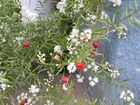Note: This is a project under development. The articles on this wiki are just being initiated and broadly incomplete. You can Help creating new pages.
Asparagus racemosus - Shatavari
Satavari or Asparagus racemosus is a species of asparagus common throughout Nepal, Sri Lanka, India and the Himalayas. It grows one to two metres tall and prefers to take root in gravelly, rocky soils high up in piedmont plains, at 1,300–1,400 metres elevation. It was botanically described in 1799.Because of its multiple uses, the demand for Asparagus racemosus is constantly on the rise. Because of destructive harvesting, combined with habitat destruction, and deforestation, the plant is now considered "endangered" in its natural habitat.
Contents
Uses
gastric ulcers , dyspepsia, galactogogue, intrinsic haemorrhage, diarrhoea, piles, hoarseness of voice, cough, arthritis, poisoning.
Parts Used
Chemical composition
The major bioactive constituents of asparagus are a group of steroidal saponins. This plant also contains vitamins A, B 1 , B 2 , C, E, Mg, P, Ca, Fe, and folic acid. Other primary chemical constituents of Asparagus are essential oils, asparagine, arginine, tyrosine, flavonoids (kaempferol, quercetin, and rutin), resin, and tannin. acid[1]
Common names
| Language | Common name |
|---|---|
| Kannada | halavu makkala taayi beru |
| Hindi | shatamuli |
| Malayalam | sathavari |
| Tamil | tannir-vittan |
| Telugu | abiruvu, cella |
| Marathi | NA |
| Gujarathi | NA |
| Punjabi | NA |
| Kashmiri | NA |
| Sanskrit | satamuli, satavari |
| English | buttermilk root, climbing asparagus, water root, wild asparagus, wild carrot |
Habit
Identification
Leaf
| Kind | Shape | Feature |
|---|---|---|
| simple | linear | Leaf Apices is Acuminate Leaf arrangement is Alternate distichous and Leaf Margins are Entire |
Flower
| Type | Size | Color and composition | Stamen | More information |
|---|---|---|---|---|
| clustered racemes | 2-4cm long | white | floers are in fragrant. Flowering from June-October |
Fruit
| Type | Size | Mass | Appearance | Seeds | More information |
|---|---|---|---|---|---|
| loose spiral | A berry, globose, red when ripe. Seeds 3-6, globose or angled | Fruting from October onwards | seeds are yellow to brow.n in colour | Seeds 3-6 | {{{6}}} |
Other features
List of Ayurvedic medicine in which the herb is used
- Vishatinduka Taila as root juice extract
Where to get the saplings
Mode of Propagation
How to plant/cultivate
Easily grown in any good garden soil. Prefers a rich sandy loam[3]
Commonly seen growing in areas
Forests, thickets, moisty soil area, Himalayas, eastwards from Kashmir.
Photo Gallery
References
External Links
- Pages that are stubs
- Ayurvedic Herbs known to be helpful to treat gastric ulcers
- Ayurvedic Herbs known to be helpful to treat dyspepsia
- Ayurvedic Herbs known to be helpful to treat galactogogue
- Ayurvedic Herbs known to be helpful to treat intrinsic haemorrhage
- Ayurvedic Herbs known to be helpful to treat diarrhoea
- Ayurvedic Herbs known to be helpful to treat piles
- Ayurvedic Herbs known to be helpful to treat hoarseness of voice
- Ayurvedic Herbs known to be helpful to treat cough
- Ayurvedic Herbs known to be helpful to treat arthritis
- Ayurvedic Herbs known to be helpful to treat poisoning
- Herbs with Leaves used in medicine
- Herbs with Roots used in medicine
- Herbs with common name in Kannada
- Herbs with common name in Hindi
- Herbs with common name in Malayalam
- Herbs with common name in Tamil
- Herbs with common name in Telugu
- Herbs with common name in Sanskrit
- Herbs with common name in English
- Habit - An armed vine.
- Index of Plants which can be propagated by Seeds
- Index of Plants which can be propagated by root division
- Herbs that are commonly seen in the region of Forests
- Herbs that are commonly seen in the region of thickets
- Herbs that are commonly seen in the region of moisty soil area
- Herbs that are commonly seen in the region of Himalayas
- Herbs that are commonly seen in the region of eastwards from Kashmir
- Herbs









